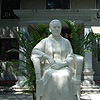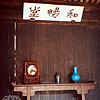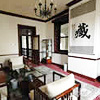On October 10, 1911, the Wuchang Uprising broke out. With one province after another declaring independence from the Qing Dynasty government. As a result, the rule of the Qing Dynasty collapsed, marking an end to the feudal autocratic monarchy of more than 2,000 years and founding the first republic in Chinese history.
To pay tribute to the 100th anniversary of the Chinese Revolution of 1911, with the guidance of Chinese Ministry of Culture, our team designed the photo album which is named "A Century of Change". Through the feature, we will share our insight from our hard work with the readers too.
Huanghuagang Mausoleum
|
 |
Located in Xianliezhong Road, the Huanghuagang Mausoleum covers an area of 13,200 square meters. It was built in 1912 to commemorate the 72 martyrs died in Guangzhou uprising on April 27,1911.
Similar to triumphal arch style, its front gate is an archway with 3 arches, on which are engraved four golden characters inscribed by Dr. Sun Yat-sun, meaning that a noble spirit will never perish. And the main buildings are the martyrs' coffin pit and the memorial archway. The square coffin pit with stone railing is 17.5 meters each side. In the center is a grave pavilion, just like a hanging bell, housing a "72 martyrs' Grave" gravestone. Behind the coffin pit is the memorial archway built to memory the 72 martyrs' merits during the period of Republic of China, at the top of which stands a 3.4-meter-height stone Statue of Liberty, demonstrating that the revolutionary martyrs has been in unremitting pursuit of liberty and democracy all along. Behind the memorial archway is a tablet inscribed a detailed record of this uprising. Inside the park, there are also many tombs including Dengzhouyuan's grave, Pandawei's grave, Yangxianyi's grave, Shijianru's temple, Fengru's grave, Fanhongtai's grave, etc.
Full of green trees and blooming chrysanthemums, this park is a well-known tourist resort in Guangzhou, famous for its tranquil environment and its buildings of grandeur and sacredness. In 1985, it was elected to be one of the eight new landscapes of Guangzhou, named "Chrysanthemums- A noble spirit". In July 2002, it was again evaluated as one of the Hot 8 scenic spots of Guangzhou in the new century, named "Holy chrysanthemums in a bright moon".
Editor: Shi Liwei
1、The Preparation of the Revolution
In November 1894, Sun Yat-sen setted up the Xingzhonghui in Honolulu. The next year in February, Sun built the headquarters of Xingzhonghui in Hongkong, and put forward the first guiding principle of the China democratic revolution.
2、The Uprising of the Revolution
The incompetent and corrupt rule of the Qing Dynasty caused extreme anger in Chinese people, finally, In June 1911, the Railway Protection Movement in Sichuan became the trigger of the Chinese Revolution of 1911.
3、The Success and Failure
December 1st, the Qing government signed the armistice with the revolutionary army, and the battle was stopped for three days. This truce is a key turning point that marks the revolution army changed the view from armed struggle to the politics of compromise.
4、Historic
The Chinese Revolution of 1911 is a great bourgeois-democratic revolution, which has far-reaching historic in modern Chinese history.




